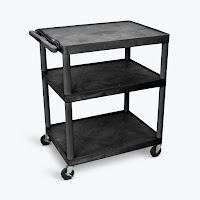Paper Guillotines
Paper guillotines may sound a bit macabre, but they’re far from the execution device they were named after. Far from cutting off the heads of spoiled French aristocrats, paper guillotines are meant to make clean, smooth, and burr-free cuts on sheets of material, usually paper. Of course, the paper guillotines and its deadly counterpart operate on the same principle: slicing down into something and producing a clean cut. Paper guillotines, of course, are designed to be perfectly safe -- as long as you’re not a flat piece of material.
Nowadays, paper guillotines are ubiquitous tools that can be useful in classrooms, offices, mailrooms, retail stores, print shops, photo printing kiosks, and even homes. These guillotines often have a heavy, non-slip base with a surface that displays a measurement and alignment guide. With this guide, users won’t need a ruler or any other separate measuring tools to get the right measurements and cut sheets down to the right size. Simply position the sheets along the right lines on the grid, then bring down the blade in one fell swoop.
But are paper guillotines safe to use? After all, they have that long blade on the side that slices down clean through various materials. The truth is, of all paper cutter types, paper guillotines are considered to be the most dangerous. This is because the cutting blade doesn’t have a protective covering. Even so, paper guillotines are still relatively safe, as long as you remember not to put any of your appendages under the sharp edge of the blade.
Paper Guillotines: A History
These paper guillotines have been around for around two centuries (its deadlier older brother has been around for longer). It was patented by the French inventor Guillaume Massiquot in 1844, and again in 1852. In 1837, meanwhile, Thirault built a model that had a flat surface with a blade attached to its surface. There was an older precursor that was already in use in the 1820s, though the device underwent a few changes over the decades to become the paper guillotine that we know today. Of course, what remains the same throughout these changes is the expectation that the paper guillotine will be able to cleanly slice through stacks of material.Nowadays, paper guillotines are ubiquitous tools that can be useful in classrooms, offices, mailrooms, retail stores, print shops, photo printing kiosks, and even homes. These guillotines often have a heavy, non-slip base with a surface that displays a measurement and alignment guide. With this guide, users won’t need a ruler or any other separate measuring tools to get the right measurements and cut sheets down to the right size. Simply position the sheets along the right lines on the grid, then bring down the blade in one fell swoop.
Safety and Efficiency
There are a lot of cutting tools out there, not the least of which are the ubiquitous scissors and box cutters. However, perhaps none of these handheld tools are as easy, quick, and smooth to use as a paper guillotines. The only disadvantage that paper guillotines have is that they can only cut in straight lines and they also have size limitations. Even with these drawbacks, however, paper guillotines are still massively helpful in a variety of endeavors.But are paper guillotines safe to use? After all, they have that long blade on the side that slices down clean through various materials. The truth is, of all paper cutter types, paper guillotines are considered to be the most dangerous. This is because the cutting blade doesn’t have a protective covering. Even so, paper guillotines are still relatively safe, as long as you remember not to put any of your appendages under the sharp edge of the blade.


Comments
Post a Comment